The Thurgood Marshall of the Women’s Movement
Cross-posted from New Deal 2.0.
Ruth Bader Ginsburg's mother left her with two key pieces of advice: Be independent, and be a lady. She's both.
I was able to talk with the Justice about everything from her mother to the role of international law in American courts to her now infamous plane ride on Thursday night during an onstage interview at University of California Hastings. There are few lawyers in history who have done more to advance women's rights than Ruth Bader Ginsburg. Here are a few things we can all learn from her.
1) "Begin at the beginning"
When Ginsburg first started working for the ACLU in the early 1970s, there was no legal protection against gender discrimination. The Equal Protection Clause of the 14th Amendment guaranteed equal rights -- but for 104 years courts had held that it applied only to race, not to gender. What, I asked her, made her think she could change that?
"The times," Ginsburg said. "The Court is a reactive institution. It's never at the forefront of social change. There's always a movement in society that's pushing the Court."
The times may have pushed the Court, but Ginsburg certainly helped. The landmark case of Reed v. Reed challenged a law stating that if a conflict arose between a man and a woman over the administration of an estate, the man would always get precedence. The plaintiff, Sally Reed, was a mother whose son had killed himself in his father's care. For the first time, the Court held that women are equally protected under the Constitution -- and Reed was able to oversee her son's estate.
Over the next few years, the ACLU Women's Rights Project, under Ginsburg's leadership, brought or helped bring several other landmark cases before the Court, including Frontiero v. Richardson, in which Justice Brennan famously wrote that romantic paternalism puts women "not on a pedestal, but in a cage."
2) Men are included in feminism
At the same time that Ginsburg was working on Reed v. Reed, she was also litigating a parallel case, known as the Moritz case, in which a man caring for his ailing mother was denied a tax break automatically available to female caregivers on account of his gender. She said incorporating the fight for male gender equality into the women's rights movement was part of her litigation strategy.
"What we wanted was to open all doors, for men and for women," she said.
This two-pronged strategy continues to be truly revolutionary to this day. Gender pressures on men play as big a role in shaping society as gender pressures on women, and it remains true that how we define masculinity is as important to the feminist movement as how we define femininity.
3) Find a partner who's really a partner
Ginsburg thinks women can have it all -- because she did. A husband, two kids, a successful career. Talking to her, it's clear that she was able to get to where she is today only because of her relationship with her husband Martin Ginsburg, whom she calls Marty.
"In a family, there's balance," she said. "When Marty was starting out and eager to make partner, I did the lion's share of taking care of [our daughter] Jane and the housework."
Ten years later, when Ginsburg was appointed to the DC Court of Appeals, her family moved with her from New York. For Marty, that meant leaving the law firm where he was a partner and transferring from Columbia Law School, where he had just gotten tenure, to Georgetown.
At the time, it was almost unheard of for a man to move for his wife's career, and many people assumed Ginsburg was commuting to DC from New York. At parties and dinners in Washington, she remembers, the confusion was even more basic: "I would be introduced as Judge Ginsburg and a hand would extend to Marty."
"That stopped when I got to the Supreme Court," she added.
4) Be a little bit deaf
On her wedding day, Ginsburg's future mother-in-law told her the secret of a happy marriage: "It helps to be a little bit deaf."
Ginsburg has taken this strategy to the Supreme Court, where her eight colleagues span a wide range of political ideologies. The judges' differing political stances have led to what she has called "spicy opinions."
"We don't merely respect, but also genuinely like each other," she said. "Scalia is my biggest buddy at the opera."
While Ginsburg and fellow justice Antonin Scalia couldn't be more different on the bench, they've been friends for three decades. They've even traveled together. On a 1994 trip to India, a picture was taken of the two together on an elephant.
"It was quite a magnificent, very elegant elephant," Ginsburg said of the experience. "And my feminist friends, when they see the photograph of Ginsburg and Scalia on this elephant, say, 'Ruth, why are you sitting in the back?'"
She's said in the past that her choice of seating was related to distribution of weight. Regardless, when it comes to the things that matter, she's not one to sit in the back. And I, for one, want to thank her for it.
The views and opinions expressed in this post are those of the author(s) and do not necessarily reflect those of MomsRising.org.
MomsRising.org strongly encourages our readers to post comments in response to blog posts. We value diversity of opinions and perspectives. Our goals for this space are to be educational, thought-provoking, and respectful. So we actively moderate comments and we reserve the right to edit or remove comments that undermine these goals. Thanks!